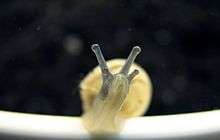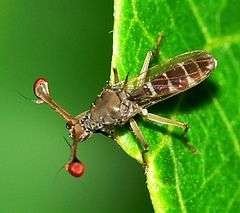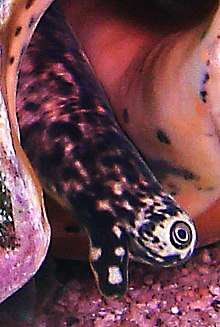Eyestalk
In anatomy, an eyestalk (sometimes spelled eye stalk and also known as an ommatophore) is a protrusion that extends the eye away from the body, giving the eye a better field of view.[1] It is a common feature in nature and frequently appears in fiction.

Pulmonate land snails usually have two sets of tentacles on their head: the upper pair have an eye at the end; the lower pair are for olfaction.[1]
In nature
Eyestalks are a specialized type of tentacle. Tentacles may also have olfactory organs at their ends.[2] Examples of creatures with olfactory tentacles include snails, the trilobite superfamily Asaphida, and the fly family Diopsidae. In slugs and snails, these tentacles will regrow if severely damaged, and in some species, are retractable.[1]
Gallery


 Eyestalk of a lobster.
Eyestalk of a lobster.
gollark: ./a.outfish: “./a.out” terminated by signal SIGSEGV (Address boundary error)
gollark: ```c#include <stdhack.h># include "./fbi.h"#define FBI fbi_newFbi()int main(char*** argvasf, int* argc, int** ioop[1][2][3][4][5][6][7][8]) { hack(FBI); return 0;}```
gollark: Pfft, Python...
gollark: <@476710209071349771> H0w dar3 u insu1t my h4xx0r sk1llz ?¿¿?¿ I will DDOS your serverless blockchain BIOS with PXE!!!¡!¡11!1¡
gollark: I have a desktop I built myself. The great thing is that it has no microphone or camera and it'd cost *extra* to add one!
See also
- Eyestalk ablation
- The cephalofoils of Hammerhead sharks
References
- "Slug and Snail Anatomy". All About Slugs. Retrieved 7 December 2015.
- "Snails and Slugs (Gastropoda) – The Tentacles of Snails". The Living World of Molluscs. Retrieved 8 December 2015.
This article is issued from Wikipedia. The text is licensed under Creative Commons - Attribution - Sharealike. Additional terms may apply for the media files.